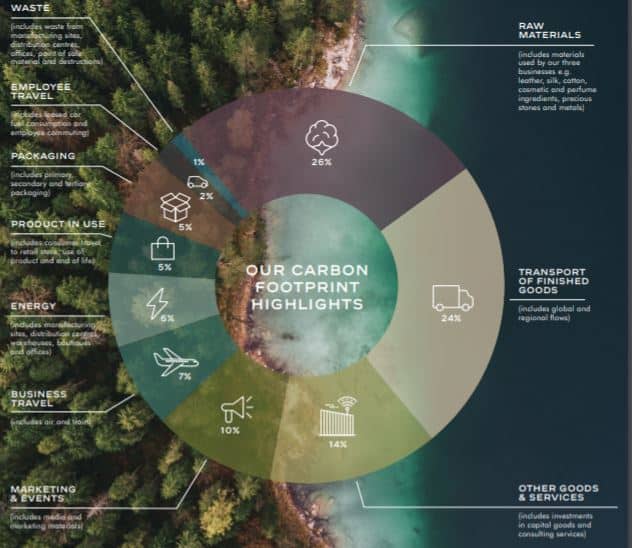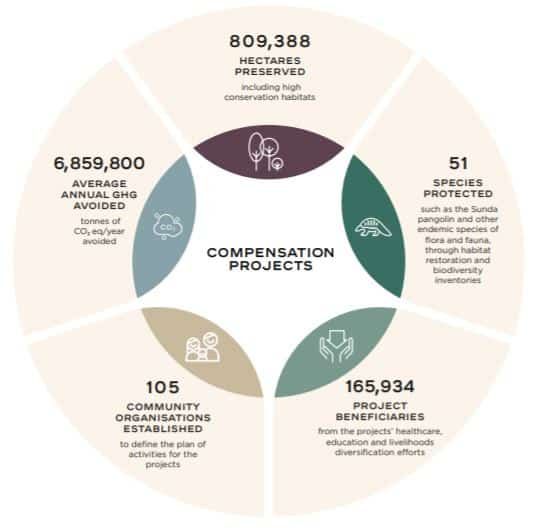Chanel has invested $25 million in carbon credit offsets that reduce or remove 6.9 million metric ton of emissions per year, according to its climate report.
The French luxury brand published its Mission 1.5 report detailing its climate action plan to 2030.
Chanel committed to invest in nature-based solutions to remove and avoid emissions at least equal to its full footprint. It’s part of the major fashion house climate strategies to reduce its carbon emissions.
Chanel’s Carbon Emissions
Chanel aims to deliver its ambition for a low carbon future through two commitments: reduce and accelerate.
Commitment 1: Reduce through energy efficiency
Reduce means cutting Chanel’s scope 1 and 2 emissions by 50% by 2030 and its value chain emissions (Scope 3) by 40% by 2030. Part of this climate pledge is also the goal to shift to 100% renewable electricity across its operations by 2025.
As of 2021, Chanel recorded a total emissions of 870,800 tCO2e, with the following breakdown:
- Scope 1: 19,600
- Scope 2: 22,200
- Scope 3: 829,000
The image below shows the components of the firm’s total carbon footprint.
Reducing its carbon emissions involves many strategies. A major part of that is using cutting-edge architecture that promotes low carbon footprint buildings.
And so Chanel strives to follow the most exacting certification standards on energy efficiency for its boutiques.
These include LEED (Leadership in Energy and Environmental Design), and BREEAM (Building Research Establishment Environmental Assessment Method) and HQE (Haute Qualité Environnementale).
As for its Scope 3 emissions reduction efforts, the company is setting high standards for its raw materials. They’re sourced from suppliers or growers that use a more regenerative and low carbon approach to agriculture.
Chanel is also opting for lightweight packaging products that have a lower carbon footprint. It also has been using reusable packaging for some of its foundation products.
Employee travel (7% of total emissions) is also cut down by using video conference meetings.
Commitment 2: Accelerate with carbon credit offsets
As per Chanel’s Mission 1.5 report:
“Reducing the impact of our business on climate change is a part of our journey to achieve Mission 1.5°, but we also recognise the role we can play in accelerating the transition to a low-carbon future beyond our own operations and value chain.”
Accelerate involves helping to speed up the transition to a lower carbon and more resilient planet. This is where Chanel seeks to invest in nature-based solutions to avoid and remove CO2 equal to its global emissions.
The fashion company also supports initiatives that protect and restore the environment. At the same, building resilience in communities to adapt to climate change.
In the past year, Chanel began investing in two separate funds which help advance its commitment to accelerate and adapt. These are:
Livelihoods Carbon Fund (LCF3): investing in LCF3 aims to source high-quality certified carbon credit offsets through carbon projects that restore natural ecosystems.
Other nature-based projects include agroforestry and regenerative agriculture. The LCF3 fund aims to create positive social, economic, and environmental impact for the communities it partners with.
Landscape Resilience Fund (LRF): Chanel is the anchor investor and sits on the board of LRF. It’s an independent foundation co-developed by climate solution company South Pole and the World Wide Fund for Nature (WWF).
The fund helps enable the most vulnerable people in rural landscapes to adapt to climate change by financing small businesses and projects. They promote climate resilient agriculture, forestry and sustainable development.
Below is the consolidated overview of the impacts of the carbon projects that Chanel invested in 2021. The results are based on the total contribution from investors.
-
As shown in the image above, Chanel’s investments in carbon credit offset projects remove or reduce about 6.9 million metric tons of CO2e a year.
The projects support the livelihoods of communities in five landscape areas in Africa, Southeast Asia and Latin America.
Internally, Chanel is also imposing an internal carbon price of $60 per ton of CO2. The fashion house is using this carbon pricing system to assess all its major investments. It acts as an incentive to develop projects that will help reduce the company’s carbon footprint.
Between 2019 and 2024, Chanel is investing over $55m in a collection of carbon projects that protect and preserve forests, mangroves, and peatlands.
These projects more than offset the carbon emissions of the firm’s operations and value chain, meeting its goal to be carbon neutral from 2019 onwards.




